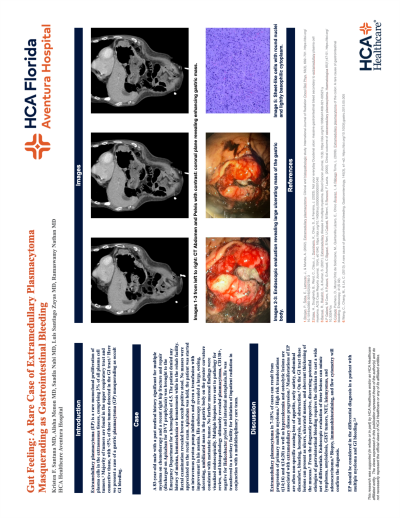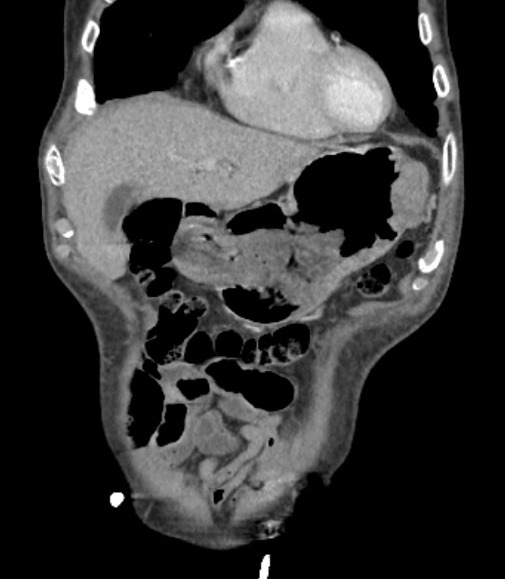Monday Poster Session
Category: GI Bleeding
P2509 - Gut Feeling: A Rare Case of Extramedullary Plasmacytoma Masquerading as Gastric Bleeding
Monday, October 28, 2024
10:30 AM - 4:00 PM ET
Location: Exhibit Hall E

Has Audio

Kristen Santana, MD
Aventura Hospital
Aventura, FL
Presenting Author(s)
Kristen Santana, MD, Alisha Menon, MD, Saadia Nabi, MD, Luis G. Santiago Zayas, MD, Ramasamy Nathan, MD
Aventura Hospital, Aventura, FL
Introduction: Extramedullary plasmacytoma (EP) is a rare monoclonal proliferation of plasma cells in the extraosseous tissues, comprising 3% of all plasma cell tumors.1 Majority of tumors are found in the upper respiratory tract and connective tissue, with < 5% of these tumors detected in the GI tract.1 Here we present a case of a gastric plasmacytoma (GP) masquerading as occult GI bleeding.
Case Description/Methods: A 83-year-old male with a past medical history significant for multiple myeloma on chemotherapy and a recent right hip fracture and repair (discharged on Apixaban for DVT prophylaxis) was brought to the Emergency Department for a hemoglobin of 4.5. The patient denied any history of melena, hematochezia or hematemesis while in the rehab facility. Rectal examination revealed brown occult positive stool. No masses were appreciated on the rectal exam. Apixaban was held, the patient was started on intravenous proton pump inhibitors and given a transfusion with improvement in his anemia. His endoscopy revealed a large, oozing, ulcerating, umbilicated mass in the gastric body on the greater curvature consistent with metastatic tumor. No further mucosal findings were visualized endoscopically. Multiple biopsies were sent to pathology for review, and histopathology ultimately revealed plasmacytoma, CD138+, negative for Helicobacter pylori and intestinal metaplasia.He was transferred to a tertiary facility for initiation of inpatient radiation in conjunction with a multidisciplinary care team.
Discussion: Extramedullary plasmacytoma in 7-18% of cases can result from progression of primary multiple myeloma..2 High risk translocations t(14;16) and t(14;20) as well as hypercalcemia and osteolytic lesions are associated with extramedullary disease progression.3 Manifestations of EP are often non-specific causing loss of appetite, early satiety, abdominal discomfort, bloating, hemoptysis, and obstruction.4 On the GI tract these lesions can present as ulcers, ulcerated masses, and aberrant thickening of the mucosa.5 From the diagnostic perspective, discerning potential etiologies of gastrointestinal bleeding requires the clinician to cast a wide net of differentials. Endoscopic evaluation of these lesions can mimic lymphoma, amyloidosis, GIST tumors, NET, leiomyomas, and adenocarcinoma. 6 Biopsy, immunohistostaining, and flow cytometry will confirm the diagnosis.
EP should be considered in the differential diagnosis in a patient with multiple myeloma and GI bleeding.2,6

Disclosures:
Kristen Santana, MD, Alisha Menon, MD, Saadia Nabi, MD, Luis G. Santiago Zayas, MD, Ramasamy Nathan, MD. P2509 - Gut Feeling: A Rare Case of Extramedullary Plasmacytoma Masquerading as Gastric Bleeding, ACG 2024 Annual Scientific Meeting Abstracts. Philadelphia, PA: American College of Gastroenterology.
Aventura Hospital, Aventura, FL
Introduction: Extramedullary plasmacytoma (EP) is a rare monoclonal proliferation of plasma cells in the extraosseous tissues, comprising 3% of all plasma cell tumors.1 Majority of tumors are found in the upper respiratory tract and connective tissue, with < 5% of these tumors detected in the GI tract.1 Here we present a case of a gastric plasmacytoma (GP) masquerading as occult GI bleeding.
Case Description/Methods: A 83-year-old male with a past medical history significant for multiple myeloma on chemotherapy and a recent right hip fracture and repair (discharged on Apixaban for DVT prophylaxis) was brought to the Emergency Department for a hemoglobin of 4.5. The patient denied any history of melena, hematochezia or hematemesis while in the rehab facility. Rectal examination revealed brown occult positive stool. No masses were appreciated on the rectal exam. Apixaban was held, the patient was started on intravenous proton pump inhibitors and given a transfusion with improvement in his anemia. His endoscopy revealed a large, oozing, ulcerating, umbilicated mass in the gastric body on the greater curvature consistent with metastatic tumor. No further mucosal findings were visualized endoscopically. Multiple biopsies were sent to pathology for review, and histopathology ultimately revealed plasmacytoma, CD138+, negative for Helicobacter pylori and intestinal metaplasia.He was transferred to a tertiary facility for initiation of inpatient radiation in conjunction with a multidisciplinary care team.
Discussion: Extramedullary plasmacytoma in 7-18% of cases can result from progression of primary multiple myeloma..2 High risk translocations t(14;16) and t(14;20) as well as hypercalcemia and osteolytic lesions are associated with extramedullary disease progression.3 Manifestations of EP are often non-specific causing loss of appetite, early satiety, abdominal discomfort, bloating, hemoptysis, and obstruction.4 On the GI tract these lesions can present as ulcers, ulcerated masses, and aberrant thickening of the mucosa.5 From the diagnostic perspective, discerning potential etiologies of gastrointestinal bleeding requires the clinician to cast a wide net of differentials. Endoscopic evaluation of these lesions can mimic lymphoma, amyloidosis, GIST tumors, NET, leiomyomas, and adenocarcinoma. 6 Biopsy, immunohistostaining, and flow cytometry will confirm the diagnosis.
EP should be considered in the differential diagnosis in a patient with multiple myeloma and GI bleeding.2,6

Figure: Extramedullary plasmacytoma on the on the greater curvature of the gastric body.
Disclosures:
Kristen Santana indicated no relevant financial relationships.
Alisha Menon indicated no relevant financial relationships.
Saadia Nabi indicated no relevant financial relationships.
Luis Santiago Zayas indicated no relevant financial relationships.
Ramasamy Nathan indicated no relevant financial relationships.
Kristen Santana, MD, Alisha Menon, MD, Saadia Nabi, MD, Luis G. Santiago Zayas, MD, Ramasamy Nathan, MD. P2509 - Gut Feeling: A Rare Case of Extramedullary Plasmacytoma Masquerading as Gastric Bleeding, ACG 2024 Annual Scientific Meeting Abstracts. Philadelphia, PA: American College of Gastroenterology.
